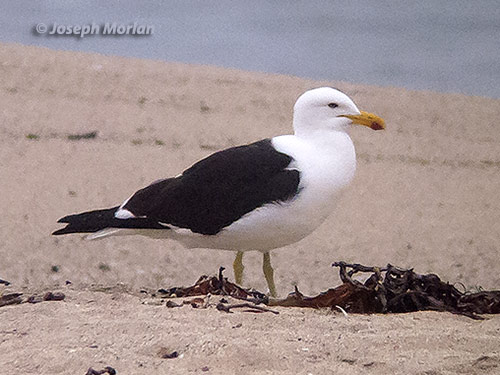Pilarcitos Creek Mouth, Half Moon Bay, San Mateo County, CA
30 May 2016
Joseph Morlan

Kelp Gull (Larus dominicanus)
Pilarcitos Creek Mouth, Half Moon Bay, San Mateo County, CA
30 May 2016
Joseph Morlan

Chris Hayward and Malia DeFelice found the adult KELP GULL about 7pm this evening at the mouth of Pilarcitos Creek in Half Moon Bay. I arrived about 7:30 and had the bird in view for about 15 minutes before it flew north. It landed with another group of gulls but disappeared again. There were numerous flocks of gulls scattered on the beach. It was in a mixed flock of Western and California Gulls. This is presumably the same Kelp Gull which moved between Año Nuevo, Half Moon Bay and the Farallons in April and May of last year and which was photographed on Southeast Farallon April 26 of this year. I attempted to digiscope the bird with the results seen here. See also Chris Hayward's photos which show the red orbital.
Description
The following description is based on memory and on photos:
A large adult gull appearing slightly smaller than adjacent Western Gulls but clearly larger than nearby California Gulls. The solid black mantle was distinctive and did not contrast with the black wing-tips. Wing tips showed no white tips and no mirrors. Kelp Gulls usually show a small white mirror on p10 but it was not evident on this individual. However photos of the bird from last spring also lack a mirror. The white scapular and tertial crescents were narrow and appeared worn. The rest of the body including the tail was white. The bright yellow bill was not as stout as that of Western Gull, but definitely heavier than that of California Gull. A large red spot was evident on the gonys where it appeared to be well defined and not smeared as often seen in the similar Lesser Black-backed Gull (Larus fuscus). The legs were dull yellow-green, similar to the leg color of adjacent California Gulls, although averting a bit more yellow. The iris was pale with a red orbital ring.
Identification
Identification is tricky with a number of similar species possible. The Yellow-footed Gull (Larus livens) has a much heavier bill, yellow orbital and usually lacks green tones to its legs and feet. The nominate race of Lesser Black-backed Gull (Larus fuscus fuscus) has a mantle as dark as Kelp Gull, but normally has more smudging to the red gonydeal spot. Its bill is slimmer and its legs more yellow rather than yellow-green. It is usually a smaller, less bulky bird, closer to California Gull in size.
Discussion
Kelp Gull was added to the California State list on 9 January 2016 list after the acceptance of three records from the San Francisco area as follows:
All three are considered to be the same individual. Since then, there have been three additional reports:
All three were photographed and are currently under review. The Farallon bird is probably returning from the previous year and it has been suggested that the San Gabrial record may be the same individual. Photos of the Humboldt Bay bird are inconclusive in my opinion, seeming to show a paler mantle than would be expected of a Kelp Gull.
Of the five subspecies of Kelp Gull recognized by Clements/eBird, the nominate race is the most widespread occurring in South America, New Zealand and Australia and is the subspecies most likely to occur as a vagrant in North America. Birds from South Africa are the race L. d. vetula which differs in having a dark eye and a shorter bill. It is sometimes split as a separate species called Cape Gull. Three other subspecies are usually recognized from Antarctica, Subantarctic islands and Madagascar (Clements, IOC, Jiguet). Of these L. d. austrinus of Antarctica and South Georga has a shorter bill and legs and its legs often lack green tones.
New Zealand populations often go under the name "Southern Black-backed Gull," a name used by Howard & Moore through their 2nd edition, but the name Kelp Gull is otherwise universal. A recent publication by Jiguet et al. (2012) recommends separation of the Australia/New Zealand population as a distinct subspecies (L. d. antipodus). This suggestion has been adopted by HBW (online version); however the latest Howard & Moore considers the species to be monotypic.
References
Burger, J., Gochfeld, M. & Garcia, E.F.J. (2016). Kelp Gull (Larus dominicanus). In: del Hoyo, J., Elliott, A., Sargatal, J., Christie, D.A. & de Juana, E. (eds.). Handbook of the Birds of the World Alive. Lynx Edicions, Barcelona. (retrieved from http://www.hbw.com/node/53975 on 31 May 2016).
Clements, J. F., T. S. Schulenberg, M. J. Iliff, D. Roberson, T. A. Fredericks, B. L. Sullivan, and C. L. Wood.
2015. The eBird/Clements checklist of birds
of the world: v2015.
Dickinson, E.C., J.V. Remsen Jr. & L. Christidis (Eds). 2013-2014. The Howard & Moore Complete Checklist
of the Birds of the World. 4th. Edition, Vol. 1, 2, Aves Press, Eastbourne, U.K.
Gill, F & D Donsker (Eds). 2016. IOC World Bird List (v 6.2)
Howell, S. N. G. & J. Dunn. (2007) A Reference Guide to Gulls of the Americas. Houghton Mifflin.
Jiguet, F. (2002) Taxonomy of the Kelp Gull Larus dominicanus Lichtenstein inferred from biometrics and wing plumage pattern, including two previously undescribed subspecies. Bull. Brit. Orn. Club 122(1): 50-71. [PDF]
Jiguet, F., Capainolo, P. & Tennyson, A.J.D. (2012) Taxonomy of the Kelp Gull Larus dominicanus Lichtenstein revisited with sex-separated analyses of biometrics and wing tip patterns. Zool. Stud. 51(6): 881-892. [PDF]